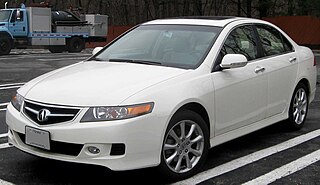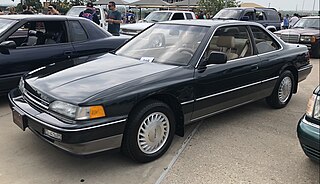
The Honda Integra, sold in North America as the Acura Integra and later the Acura RSX, is an automobile produced by the Japanese company Honda from 1985 until 2006, and then since 2021. It succeeded the Quint as a more luxurious and sport-oriented derivative of the Civic. The Integra was one of the launch models for Acura in the US in 1986 alongside the Acura Legend. Throughout its production run, the Integra was highly regarded for its handling and performance. The 1995–2001 Integra Type R is widely regarded as one of the best front-wheel-drive cars of all time.

The Honda Accord, also known as the Honda Inspire in Japan and China for certain generations, is a series of automobiles manufactured by Honda since 1976, best known for its four-door sedan variant, which has been one of the best-selling cars in the United States since 1989. The Accord nameplate has been applied to a variety of vehicles worldwide, including coupes, station wagons, hatchbacks and a Honda Crosstour crossover.

The Acura TSX is a compact executive car manufactured by Honda and sold through its Acura division from 2003 to 2014. The TSX spanned two generations, both derived from the corresponding Japanese/European versions of the Honda Accord, which were more compact and sporting-oriented than its larger North American counterpart, the latter platform which also used for the Acura TL which slotted above the TSX in Acura's lineup. All TSXs were built in Sayama, Saitama, Japan.

The Honda Prelude is a sports car produced by the Japanese company Honda over five generations from 1978 to 2001.

The Honda Inspire is a mid-size sedan derived from the Honda Accord chassis. The first Inspire debuted in late 1989 as the Accord Inspire, a sister nameplate to the Honda Vigor. It was sold at different retail channels in Japan, known as Honda Verno for the Vigor/Saber, and as the Inspire at Honda Clio stores.

The Acura MDX is a mid-size luxury crossover SUV with three-row seating produced by the Japanese automaker Honda under its luxury Acura division since 2000. The alphanumeric moniker stands for "Multi-Dimensional" luxury. It has ranked as the second-best selling mid-size luxury SUV after the Lexus RX in the U.S.

The fourth-generation Honda Integra, produced by Honda, was introduced in Japan on 13 April 2001 and produced from July 2001 until August 2006. It was introduced in North America on 2 July 2001 as the Acura RSX, the name a part of Acura's naming scheme changing the names of its models from recognizable names like "Integra" or "Legend" to alphabetical designations in order for buyers to build more recognition to the marque, and not the individual cars.

The Acura CL is a midsize grand tourer manufactured by Honda's Acura brand from 1996 until 2003. The CL is often thought to have been a replacement for the Acura Legend coupe. It was not directly related to the first gen TL either, a Japanese-built model which replaced the Vigor and had a longitudinal engine layout. With the advent of the second generation TL in 1999, the transverse engined CL became more precisely a TL coupe. All Acura CLs were built at Honda's plant in East Liberty, Ohio, which is also the plant that builds the Honda Civic. The second generation TL and the Honda Accord upon which the Acura CLs were based, are built at Honda's plant in Marysville, Ohio, a few miles away from East Liberty. The CL was the first Acura to be built in the United States.

The Acura Legend is a mid-size luxury car manufactured by Honda from Japan. It was sold in the U.S. and Canada under Honda's luxury brand, Acura, from 1985 until 1995. It was the first flagship sedan sold under the Acura nameplate, until being renamed in 1996 as the Acura 3.5RL. The 3.5RL was the North American version of the KA9 series Honda Legend.

The Honda CR-X del Sol is a two-seater targa-top car manufactured by Honda from 1992 until 1998. Despite the body resemblance to a mid-engine car design, the del Sol is based on the front-engined Honda Civic platform and was the successor to the Honda CR-X.

The Honda Domani (ホンダ・ドマーニ) is a car made by Honda and marketed in east Asia, including Japan. The car was mutually developed during Rover's collaboration with Honda. It was introduced in November 1992, replacing the Concerto in Honda's lineup, although that model lasted until 1995 in Europe.

The Acura CSX is Acura's subcompact executive car exclusively designed for the Canadian market. Like the EL, it was only available in Canada and built in Alliston, Ontario, Canada. For the 2013 model year, the ILX was introduced as the CSX's replacement and is available in both the United States and Canada.

The fourth-generation Honda Civic is a Japanese sub-compact automobile. It was produced by Honda from 1987 until 1991 with the wagon continuing in production in some markets until 1996. The suspension had a new double-wishbone suspension in the front and an independent suspension in the rear, the wheelbase was increased to 250 centimetres (98 in) from that of the third-generation Civic, and the body was redesigned with a lower hood line and more glass, resulting in less drag. The redesigned Civic was introduced in 1987 for the 1988 model year. The fourth-generation Civic would be available in three variants; 3-door hatchback, 4-door sedan and 5-door wagon with various trim levels offered in each variant.

The sixth-generation Honda Civic is an automobile produced by Honda from 1995 until 2000. It was introduced in 1995 with 3-door hatchback, 4-door sedan and 2-door coupe body styles, replicating its predecessor's lineup. The sixth-generation Civic offered two new 1.6-liter 4-cylinder engines and a new continuously variable transmission (CVT) on the HX model. The coupe and sedan are 2.3 in (58 mm) longer and the hatchback is 4.3 in (109 mm) longer than the previous-generation Civic. This was the last generation of Civic to have front double-wishbone suspension, as the succeeding seventh generation would change the front suspension to a MacPherson strut.

The seventh-generation Honda Civic is an automobile produced by Honda from 2000 until 2005. It debuted in September 2000 as a 2001 model. Its exterior dimensions stayed similar to the outgoing predecessor, with interior space significantly increased, bumping it up to the compact car size designation. A notable feature was the flat rear floor that gave better comfort to the rear seat passengers. This generation abandoned the front double wishbone suspension, used previously from fourth to sixth generations, replacing it with MacPherson struts. This generation was the last to offer 4WD variants.

The eighth-generation Honda Civic is a range of compact cars (C-segment) manufactured by Honda between 2005 and 2012, replacing the seventh-generation Civic. Four body styles were introduced throughout its production run, which are sedan, coupe, and both three-door and five-door hatchback. The sedan version was introduced with two distinct styling for different markets, with one of them sold as the Acura CSX in Canada and as the Ciimo 1.8 in China from 2012 until 2016. The hatchback versions formed the European-market Civic range, which received a different architecture, body design and smaller footprint, and solely produced in Swindon, United Kingdom.

The Honda Vigor is a premium sedan that was derived from the Honda Accord. It was sold in Japan through the Honda Verno dealer network from 1981 until 1995, and sold in North America from June 1991 until 1994 as the Acura Vigor. Early Vigors were more upmarket versions of the Accord, and served as Honda's flagship until the arrival of the Honda Legend. In 1989, the Vigor would differentiate itself further from the Accord with unique styling and an available longitudinal five-cylinder engine, and a twin to the Vigor was introduced with the Honda Inspire, available at Honda Clio dealerships.

The Acura ILX is a compact car (C-segment) manufactured and marketed by Honda under the Acura brand, based on the ninth-generation Civic sedan. The ILX replaced the Canadian market exclusive Acura CSX. The gasoline-electric hybrid version was Acura's first.

The third generation Honda CR-V was launched for the 2007 model year. It went on sale in the U.S. during late September 2006. Unlike preceding models, it features a rear liftgate rather than a side-opening rear door and no longer has the spare tire mounted on the rear door. The new CR-V is lower, wider and shorter than the previous models; the length decrease is attributed mostly to the fact that the spare wheel no longer adds length to the back of the vehicle. A lowering of the center of gravity is another benefit of the spare wheel being located underneath the rear cargo area. The center rear seat pass-through was also introduced as a new feature on the third generation.
The A-Spec and Type-S marques represent the high-performance divisions of cars produced by Acura. Acura utilized the Type R marque for their high-performance division of cars from 1997 to 2001, when they produced the Acura Integra Type R. The first vehicle offered as a Type-S variant was the 2001 Acura CL, and the first vehicle offered as an A-Spec variant was the 2003 Acura TL in Canada and the 2002 Acura RSX in the US.
























